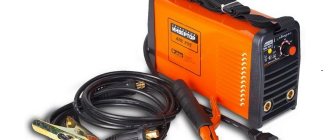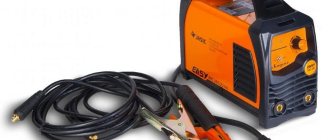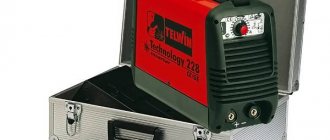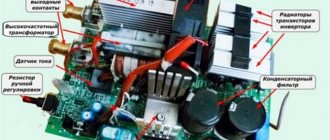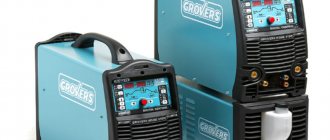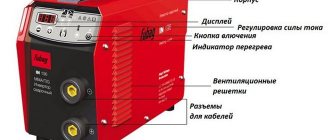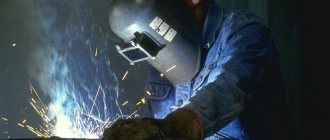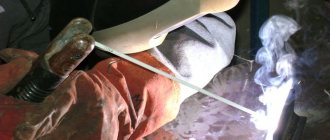Welding inverter Svarog ARC 205
Technical characteristics of the inverter Svarog ARC 205 (J96)
When welding, direct current electrodes UONII-13/55, UONI-13/55 and their modifications are used. Universal electrodes ANO-4S, MR-3, OZS-12 are applicable.
The best welding quality was observed when using electrodes with a diameter of 1.5–4.0 mm.
The welding machine is equipped with all cables, electrode holders and terminals necessary for operation, and is equipped with a welding helmet. It is quite compact, its dimensions are 336x120x198 mm, and its weight does not exceed 7.8 kg.
Technical characteristics of the welding machine Svarog TECH ARC 205 B (Z203)
The device is packed in a stylish case, allowing you to carry both the device itself and all the necessary accessories, as well as protective equipment. A set of additional functions ensures comfortable work for the welder on site. The outer shell with protection level IP 21 protects the device from foreign objects and drops of water falling vertically onto the housing.
The inverter is suitable for welding in private households, garages or small car repair shops. It is indispensable when carrying out construction and installation work of any volume associated with visiting the site, and is applicable in the housing and communal services sector.
The device is convenient to use as part of the equipment of mobile emergency services complexes, in small-scale production. Low weight and dimensions allow welding in hard-to-reach places when repairing metal structures.
Operating principle of a welding inverter
Welding with the Svarog ARC 205 inverter is carried out with direct current (DC) using inverter technology. The device is powered from a conventional single-phase network 220 V, 50 Hz. In the absence of a stationary power source, it is possible to connect to a gasoline or diesel generator that provides voltage in the range of 185 V–260 V.
The AC supply voltage is converted into DC by the mains rectifier and inductor. The resulting direct current is supplied to the IGBT block of power bipolar transistors. It inverts direct current into RF alternating current with a frequency of 20–50 kHz.
The step-down transformer reduces the voltage to the operating level, after which it is rectified again and supplied to the operating connectors located on the front panel of the case.
Such preliminary conversion to high-frequency current allows the use of a transformer with very small dimensions. Compared to “classic” welding machines, the inverter weighs several times less, has better technical characteristics and efficiency.
The high quality of the welding process is ensured by a control unit with digital signal conversion (DSP).
Key features of the device:
- the presence of the Hot Start function (hot start) when igniting the electric arc;
- equipped with Antistick anti-stick option;
- adjusting the arc force (increasing power) guarantees deep penetration and a flat, even seam even at low current;
- 80% load duration when operating at a maximum current of 180 A;
- the ability to connect to a container with argon with subsequent welding of “non-ferrous metal” with non-consumable electrodes using the TIG method;
- equipped with a fan, protection against overheating and overvoltage of a single-phase 220 V network;
- the presence of a switchable idle voltage reduction system VRD.
inverter Svarog
Hello Everyone! I decided to buy an inverter this year, although I have an excellent welder, I wound it on a toroidal core made from the stator of a burnt-out 7 kW induction machine, everything would be fine, but carrying 45 kg plus cable in one mug is a little annoying. First of all, I decided surf the Internet to read what anyone has to say, so I wandered into the City of Masters. I haven’t come across a more detailed and long-lived forum on this topic. I read it, asked the price, and chose four models for myself: FORCAGE 161 (11800), NEON 160 (11800), Svarog ARC 165 (7700) and ELITECH AIS 160 SA (8410), (prices in Izhevsk companies). I was more inclined towards FORCING, just look at its official. characteristics according to Upit..But, firstly, the price, and secondly, FORCAGE and NEON are sold “naked”: no welding cables, no holder, no ground clamp - nothing! But it all “pulls” another one and a half two rubles. In addition, I read either here or in other forums that in Russian NEONs there is only a housing and a trans, and the boards come entirely from China, although I also read a diametrically opposite statement from a person who, according to him, had an internship at the factory in Nizhny, and personally saw how boards are produced and tested there. Included with ELITECH, as part of the promotion, is a “chameleon” mask, a funny thing, but in my experience the thing is very capricious and requires very careful handling, we have two at our enterprise masks made by USA, one died after six months (fell from about 4 meters), and the second, by itself, after 1.5 years. But “let’s go back to our sheep” On July 12 I walk along Krasnoarmeyskaya Street “I’m not touching anyone” and I hear someone yelling through a megaphone: “Promotion in the Elektrograd store! Discount on Svarog welding inverters! You can cook it yourself.” , couldn’t resist walking up, trying it, cooking it... In short, I bought a Svarog ARC 205 case for NINE pipes. The device was made by JASIK (China), which is written in black and glossy white on the cover of the passport, so there can be no illusions about the Russian spill. The kit includes: an inverter, a cable with a connector and an electrode holder, a cable with a connector and a ground clamp, a brush-hammer for metal (a small thing, of course, but, you see, it’s nice), a welding shield (glass about C3 or a little higher) and actually the case itself is where all this is packed. I immediately laid out the shield (with a mask it’s more common, but that’s what anyone cares about), and put an extension cord in the vacant space: SHVVP wire 2*4mm/sq 30m, with a twin socket for outdoor installation (so that you can connect an angle grinder ) I bought everything there. Now, FINALLY, about the operation of the device. I’ve used it three times so far, not counting the “test drive” in the store when purchasing. Twice in my garden (I made the proverbial fence) everything is OK because We have our own transformer substation on the array and there are no problems with the quality of the voltage. And they also invited me to tease him, I had to work almost outside the city, I don’t know what the voltage in the network is, naturally, I didn’t have a multimeter with me. I had to get power through an extension cord of unknown manufacture (it wasn’t long enough) the only thing I could figure out was: 50m 10A, how many volts reached the unit in the end I can’t say, but the current regulator had to be turned to maximum, the arc left much to be desired for the best, it seemed to go in jerks or jerks, but, nevertheless, I completed the work. (In all cases, approx. MP-3 electrodes, 3 mm in diameter) CONCLUSION: for a home for a family, the ARC 205, with normal power supply networks, is a good unit, and because In such cases, welding is usually done in threes, so there’s no need to “steam” - this model, with a light current of up to 140A, has a duty cycle of 100%, at least I burned 3 electrodes in a row at 26-28 degrees C and the thermal protection did not work .And if you have problems with the power supply, then I advise you to take a closer look at the Ryazan FORCAGE 161, for its price the device is simply amazing!! If it weren’t for the promotion, I would definitely buy it! But, as you know, history has no subjunctive moods. PS I couldn’t resist, I disassembled the holder and connectors (not for the sake of self-interest, but for order) everything was done very carefully, somehow not even in Chinese, thoroughly tightened. The only thing I touched was the fastening of the wire on the ground clamp. I wasn’t too lazy to calculate the cross-section of the electrical cable and here everything is as stated - 16mm/sq, even surprising. If everything inside the device is also well-made, then I think it will serve normally, and, by the way, the warranty on it is 2 years, just like FORSAZH.
SVAROG ARC 205 (J96) is a stable and powerful device!
The welding inverter SVAROG ARC 205 (J96) is distinguished by stable, reliable, long-lasting operation, as well as low noise level. The main advantage over competitors is, of course, the efficiency of this inverter. In tests, the performance exceeded the 85% efficiency declared by the manufacturer.
*
What makes the welding inverter SVAROG ARC 205 (J96) stand out?
The main difference between Svarog machines with the letter index “J” is their versatility; in this case, the ARC 205 (J96) machine is distinguished by the possibility of using it for two types of DC welding: for manual arc welding with coated electrodes (MMA/RD), and also for manual argon arc (TIG/RAD).
The device has one of the most modern technological fillings, which is why it is light in weight and size, has high efficiency and is able to withstand heavy loads for a long time.
The maximum welding current of this machine is 185 A, which means that the machine can be used for welding with coated electrodes with a diameter of 4 mm, and with manual argon arc welding the maximum penetration depth can reach up to 3 mm. The polarity when welding is easily changed by switching the cables from one terminal to another.
The device has built-in additional functions “HOTSTART” and “Lift”, which are designed to facilitate the ignition of the arc and the start of welding.
Another remarkable characteristic of this product is its excellent price-quality ratio. At a low cost, it fully satisfies the basic requirements for high-quality and safe welding both for personal needs and for larger and more serious production projects, small auto repair shops, etc.
The ARC 205 welding machine, based on a modern inverter circuit, is designed for manual arc welding (MMA) and surfacing with a coated stick electrode on direct current of low-carbon steel products in industrial and domestic conditions. And when a valve TIG torch and an argon cylinder are connected to the machine, argon arc welding is possible.
The device is manufactured on the basis of modern inverter technology using powerful IGBT transistors using the principle of pulse width modulation (PWM). It features stable, reliable, long-lasting and efficient operation, portability and low noise during welding. Features of the ARC 205 device are high efficiency, low energy consumption, mobility, stable arc combustion, low open circuit voltage, self-regulation of arc power. As well as high ergonomics, modern design, ease of control.
How it works in practice
SVAROG ARC 205 (J96) is a model that never overheats and functions until the electrode burns out. This does not depend on the time of year, air temperature or metal thickness. It is almost impossible to spoil this device: according to the passport, the PV is 60%, and during testing it shows up to 80%. You don't have to wait for the inverter to cool down, as happens with its household counterparts. The power of the device is enough to weld metal 6mm thick. Rest assured, this is enough for household and installation work. In addition, such an inverter not only cooks, but also easily cuts metal.
The inverter can be used in any premises where there is a relatively free flow of fresh air, as well as in open areas in temperate climates (humidity - up to 80 percent, ambient temperature - no more than +40 degrees). When using it as part of mobile repair complexes, it is necessary to make sure that the technical parameters of these complexes and the welding installation are fully compatible with each other.
The protective category of the welding equipment in question does not allow its operation during precipitation. It's always worth remembering this.
The unit must be installed on a flat surface, and in such a way that it is provided with sufficient ventilation (without constant natural cooling of the equipment, it will very quickly fail). Dirt, particles of molten metal, and sparks are not allowed to enter the installation.
The inverter is connected to a regular power outlet, which is equipped (mandatory) with an auto-fuse. It is important to ensure tight contact of the unit plug with the socket, which will eliminate the risk of sparks during welding and surfacing. It is advisable to always use the original network cable to connect the device.
The return and forward cables for electric arc welding (MMA process) are connected to the corresponding connectors on the front side of the inverter, and then turned all the way in the clockwise direction. You need to ensure that the cables are connected as tightly as possible, otherwise there is a risk of damage to the power source and the cable connector itself.
If you plan to work with reverse polarity, connect the electrical holder (according to the rules stated above) to the “positive” connector, and the return cable to the “negative” connector. When working on straight polarity, the return cable is connected to the “plus”, and the holder is connected to the “minus”. The choice of a specific connection option depends on what welding rod you plan to use (its thickness can be from 2 to 5 millimeters), as well as on certain welding features.
To operate the inverter installation, which is the subject of this article, in TIG mode, you need to purchase a special connection set and a valve-type torch. The power tip of the burner connector is connected to the “minus”, turned and tightly fixed. The return cable is connected to the “plus”, and then the grounding clamp is fixed to the workpiece. The welding installation must be grounded. This will eliminate current leakage and the possibility of static electricity.
Gas for welding is supplied to the machine through a gas supply system, which includes:
- a cylinder filled with gas;
- gas hose (its connections should be as tight as possible);
- gearbox
Since the J96 model does not have an oscillator, the arc in TIG welding is ignited by touching.
Technical parameters of the inverter
- Welding type – MMA;
- Mains voltage (V.) – 220±15%;
- Network frequency (Hz) – 50/60;
- Rated voltage (V.) – 27.2;
- Current range (A.) – 10–186;
- Current consumption (A.) – 8.2;
- Power consumption (kW) – 5.8;
- Open circuit voltage (V.) – 76;
- Idle power (W) – 40;
- Electrode (mm.) – 1.6–4.0;
- Power factor – 0.72; Insulation class – F;
- Degree of protection – IP 21S;
- Dimensions (mm.) – 336/120/198;
- Weight (kg) – 5.80.
